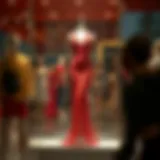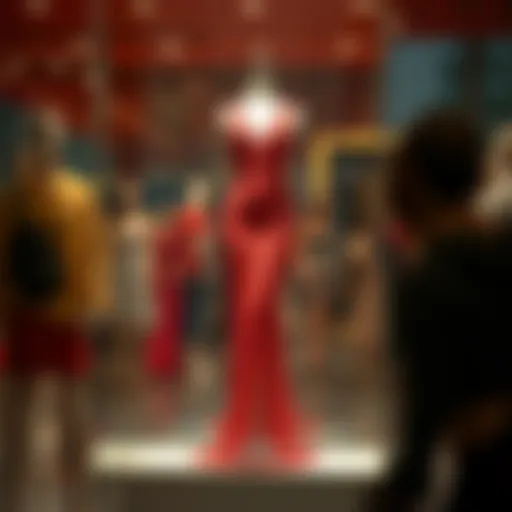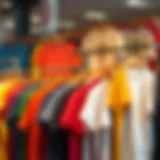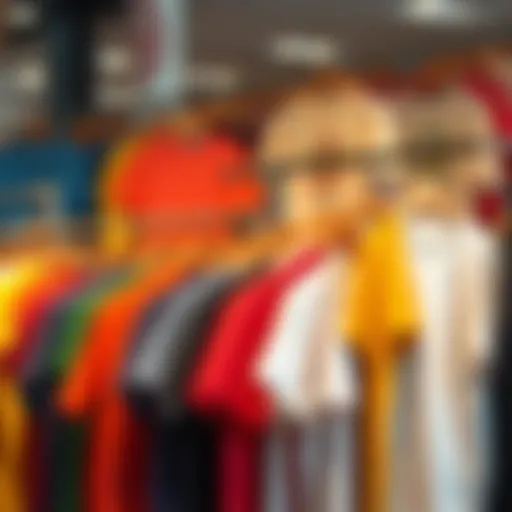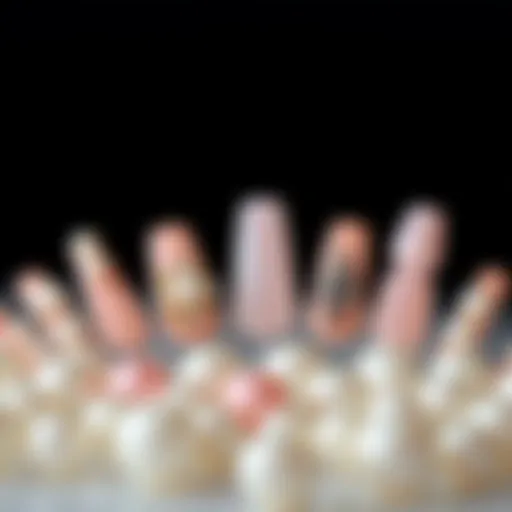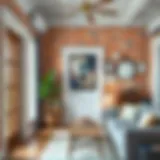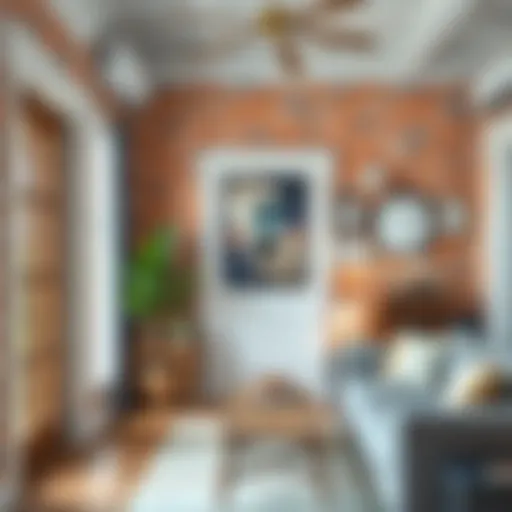Unlocking the Potential of Red Fabric Markers
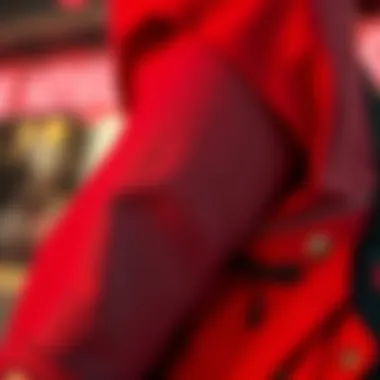

Intro
Red fabric markers have emerged as much more than simple craft supplies; they represent a tool of creativity, expression, and functional utility. In an age where personalization is king, these markers empower both amateur artisans and seasoned designers, providing means to add a splash of color to apparel, accessories, and various textiles. The striking vibrancy of red, in particular, evokes passion and boldness, making it a favored choice for distinctive creations.
This discussion aims to shine a light on the many realms where red fabric markers can transform an ordinary fabric surface into a canvas of imagination. Not only do we delve into their artistic applications, but we also explore practical benefits and maintenance tips, ensuring your projects not only look good but last long. Wherever your interests lie—be it casual crafting or professional sartorial design—understanding the capabilities of these markers will allow for informed and enriching creative endeavors.
In the following sections, we will dissect the intricacies of different fabrics, introduce style tips that enhance your fashion choices, and ultimately equip you with knowledge to fully harness the potential of red fabric markers in your projects.
Fabric Knowledge
Types of Fabrics
To understand how red fabric markers can best be utilized, one must first consider the types of fabrics available. Different materials absorb ink in distinct ways, affecting the outcome of your work. Here are some common fabric types where red fabric markers can work wonders:
- Cotton: This natural fiber is absorbent and tends to hold ink well, producing vibrant colors. It’s a go-to for many fabric projects.
- Polyester: While less absorbent, polyester blends offer durability and can handle markers with proper preparation. They tend to resist fading if cared for properly.
- Silk: This luxurious fabric adds sophistication but can be tricky; thorough testing is advisable as the ink can bleed.
- Canvas: Sturdy and durable, canvas is ideal for art projects like tote bags or home décor. The rough texture can give a unique appearance to your artwork.
By experimenting on different types of fabric, you’ll discover which works best with your style and purpose.
How to Care for Different Fabrics
Once your creations are complete, proper care is crucial for maintaining vibrancy and longevity. Here are some tips based on fabric types:
- Cotton: Generally machine washable; a gentle cycle with cold water is best to prevent fading.
- Polyester: Often machine washable too, but avoid high heat when drying to prevent melting or distortion.
- Silk: Hand wash with mild detergent. Avoid submerging for long periods to prevent dye from running.
- Canvas: You can spot-clean or wash, but always check the manufacturer's label for specific care instructions.
These steps can help preserve the vivid red of your markers across various projects, ensuring your creativity stays intact through the wear and tear of everyday life.
"A well-cared for fabric project can become both functional and a beautiful statement piece, showcasing your creativity for years to come."
In concluding this section, understanding your fabric's unique traits can radically influence your creative approach. The choices made in the initial stages can amplify the impact of red fabric markers in your artistic expression.
Style Tips
Outfit Pairing Strategies
Integrating red designs into your wardrobe using fabric markers can yield stunning results. When considering outfit pairings, think about:
- Contrast: Bright red can stand out when paired with neutral tones—think black, white, or beige for a balanced look.
- Layering: Accented pieces, like a red-embroidered jacket over a basic tee, can create an eye-catching ensemble.
- Accessorizing: Sometimes, less is more; incorporating small red elements, such as a custom drawn bag or shoes, can elevate an outfit without overpowering it.
Versatility is your ally; red fabric markers can help achieve a range of styles, from laid-back casual to chic sophistication, depending on your creative inclinations.
Seasonal Fashion Trends
Fashion is an ever-evolving sphere that thrives on innovation. Red fabric markers can aid in synchronizing your creations with current trends. Monitor seasonal colors; red often reappears in various collections. Here’s how to adapt:
- Spring/Summer: Bold floral patterns using reds can brighten light fabrics. Think summer dresses adorned with hand-drawn motifs.
- Fall/Winter: Layered looks are key; a red-stitched scarf or hat can add warmth and striking contrast against muted tones.
Be attuned to industry shifts and use your red fabric markers to enjoyably express these trends in a unique, personalized way.
Preamble to Red Fabric Markers
Red fabric markers, often overlooked amidst the myriad of art supplies, play a pivotal role in both the fashion industry and the realm of creative expression. Understanding their importance helps to unlock the potential they harbor, both in function and artistic capability. These markers value more than just colour; they transcend simple art tools, allowing a personalization that can reflect one's identity and creativity.
Definition and Purpose
At their core, red fabric markers are specialized writing instruments filled with dye or ink that is formulated to adhere to fabric surfaces. They offer a way to add vivid red hues to textiles with precision and ease. The purpose is twofold. Firstly, they enable artists, designers, and hobbyists to personalize garments and enhance fabrics — turning ordinary items into unique expressions of individuality. Secondly, they serve a practical function in repairs and alterations, bridging the gap between creativity and functionality. Whether it is a simple doodle on a tote bag or an intricate design on a T-shirt, red fabric markers provide a versatile means to create and modify fabric designs.
Evolution of Fabric Markers
The journey of fabric markers, especially the red ones, can be traced back decades, reflecting a natural evolution in artistry and design. Early iterations were predominantly fashioned for professional textile artists, with limited colour options and durability. As demand soared, manufacturers began to innovate. From simple dye-based inks, they transitioned towards the now-common synthetic inks that boast vibrant pigmentation and resistance to water and fading.
Today, red fabric markers come in various tip sizes and designs, catering to different artistic styles and needs. Individuals can opt for fine tips for intricate details or broader ones for bold strokes. The availability of non-toxic variants also marks a significant leap in this evolution, making them accessible to a wider audience, including kids and crafters alike. This progress reflects a broader shift in DIY culture, where creativity is encouraged, and self-expression is paramount. As consumers and creators, we benefit from the advancements in these tools that continue to raise the bar in textile art.
"The evolution from simple tools to versatile instruments mirrors a shift in creative expression—each stroke now tells a story."
In summary, red fabric markers represent a harmony of functional utility and artistic freedom. Their definition and usage have expanded beyond mere writing instruments to become fundamental tools for personalization, reflecting the desires and creativity of their users.
With this foundational knowledge laid out, the benefits and applications of red fabric markers further illuminate their place in the creative world.
Benefits of Using Red Fabric Markers
The use of red fabric markers is spurred by numerous benefits, each enhancing their utility for both personal and artistic needs. They are not just simple writing instruments; they are essential tools that allow individuals to express themselves creatively while also serving practical functions. Understanding these benefits is crucial as it broadens the horizon regarding the applications of these vibrant markers.
Versatility Across Mediums
Red fabric markers shine with versatility, transcending their limitations to be applied on a myriad of surfaces. From textiles to canvases and even leather, the potential uses are expansive and varied. They can transform a boring T-shirt into a statement piece or breathe new life into dull fabrics through simple yet effective designs. What's more, these markers can easily blend with other materials like acrylics or watercolors, allowing for mixed-media projects that flourish with creativity.
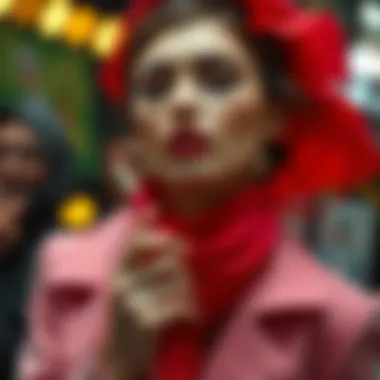

Here are a few highlights of where you can use red fabric markers:
- Textiles: Ideal for clothes, bags, and accessories.
- Art Projects: Perfect for canvas or mixed media.
- Home Decor: Great for personalizing cushions, curtains, or tablecloths.
This adaptability means that whether you're creating personalized gifts, decorating for a holiday, or simply expressing an artistic vision, red fabric markers are up to the task.
Enhancing Creative Expression
The vibrant hue of red inherently captures attention, complementing a myriad of aesthetic choices. Utilizing red fabric markers enables artists, designers, and even novices to translate their inspirations onto fabric, resulting in unique pieces that display personality and creativity. Rather than conforming to mass-produced items, individuals can convey their visions, thus enhancing their creative expression.
Consider these points:
- Ideas Flow Freely: A single stroke can ignite a flood of inspiration.
- Adaptation Without Limits: Change schemes or designs on a whim.
- Storytelling through Design: Each project can tell a story reflecting the creator’s identity.
In this way, red fabric markers serve not only as tools for application but also as mediums through which stories can unfold and creativity can flourish.
Accessibility for All Skill Levels
One of the remarkable advantages of red fabric markers is their accessibility. These tools do not discriminate; they are designed in a way that welcomes users from various backgrounds to engage with fabric art. Whether you’re a seasoned artist or a novice just starting, the easy-to-hold design and the reliability of the ink make them user-friendly and efficient.
- No Special Skills Required: Achieve great results without extensive training.
- Quick Cleanup: Mistakes can be easily corrected with a damp cloth before the ink sets.
- Affordability: Many quality markers are available at a range of prices, making them accessible to nearly everyone.
Applications of Red Fabric Markers
The practical uses of red fabric markers extend far beyond mere decoration. When delving into the applications of these tools, it’s evident that they allow for an expression of personality, creativity, and oftentimes necessity. With their all-around usefulness, red fabric markers have carved out a niche that resonates with both casual hobbyists and professional artists alike.
Customizing Clothing
Designing Unique Apparel
In the realm of fashion, customizing clothing is more than just a trend; it’s a way for individuals to voice their identities. Red fabric markers play a pivotal role in designing unique apparel, which serves as a canvas for personal expression. One standout characteristic of this practice is the spontaneity it offers. With a few strokes, one can transform a simple shirt into a masterpiece. This immediacy and the potential for creativity make it a favored choice for many.
A distinctive aspect of designing unique apparel is the energetic pop of color red brings. In many cultures, red is associated with passion and courage. This makes it not just a color but also a statement. Whether one is adding a personal logo or creating an intricate design, using red can signify bold choices, enhancing the garment's appeal.
However, one should also consider that while customization can be immensely rewarding, it requires thoughtfulness. A poorly executed design might overshadow the original garment. Thus, careful planning can lead to conducive results that harmoniously blend individual style with quality fabric.
Repairing and Revamping Garments
Red fabric markers are also excellent for repairing and revamping garments that might otherwise end up being tossed. With the rise of sustainable fashion, this application plays a significant role in contributing to environmentally-conscious choices. A key characteristic of this method is its practicality; a simple touch-up can significantly extend a garment's life, saving money and resources.
The unique feature of using red to revamp clothing lies in its ability to mask imperfections creatively. A strategic dash of red can turn an unsightly stain into a design statement. This approach not only repairs fabric but adds a fresh twist, inviting a second life for clothing that may have been deemed outdated.
Of course, caution should be exercised. The blending of red might not always match every fabric color or texture, which can lead to mismatched appearances. Yet, when done right, revamping with a red marker creates distinctive pieces that carry stories rather than being just clothing.
Artistic Projects
Textile Art Creation
Beyond clothing, red fabric markers thrive in the world of textile art. Creating textile art can be a liberating experience, greatly influenced by the possibilities that red offers. This practice stands out because it encourages experimentation with various forms, whether it be tapestries or wall hangings.
The key trait of textile art creation is its unlimited adaptability—one can blend patterns, colors, and textures infinitely. Red fabric markers allow artists to incorporate striking hues into their designs while playing with different materials, which leads to vibrant, eye-catching outcomes. This versatility makes it a popular method among artists seeking to make bold statements.
A unique feature of this application is the potential for mixed media work, where artists can use red fabric markers alongside other mediums for texture and depth. However, it’s essential to understand how to manipulate these markers correctly, as the permanence of certain inks might put constraints on future alterations.
DIY Projects and Crafts
DIY projects and crafts also take center stage when discussing the versatility of red fabric markers. The appeal here lies in their accessibility and ease of use for people at all skill levels. From home decor to personalized gifts, the applications are vast.
A notable characteristic of DIY projects with red markers is the creativity they unleash. They allow for personalization that mass-produced items lack. For instance, turning a simple pillowcase into a one-of-a-kind gift for a friend can mean much more than simply buying a present off the shelf. The unique touch signifies thoughtfulness.
Nevertheless, DIY projects are not without their challenges. New crafters may find themselves wrestling with design execution and color saturation, as the degree of vibrancy can vary with fabric type. Thus, while the creative journey is rewarding, it often comes with a learning curve.
Event Decoration and Personalization
Discussing the applications of red fabric markers would be incomplete without mentioning their role in event decoration and personalization. Whether for weddings, parties, or community events, these markers enhance the aesthetic and ambiance. The excitement of creating visually striking decorations resonates with many who partake in organizing events.
The standout aspect here is the ability to personalize decorations in a way that mass-produced items cannot match. From table runners to fabric banners, red markers empower individuals to craft distinct environments reflective of their themes and styles.
In summary, the applications of red fabric markers reveal their role as tools of creativity. They usher in elegant customization, practical repairs, and artistic expression, all while promoting sustainability in fashion. As we explore their diverse uses, it becomes clear that these markers are more than mere art supplies; they are a gateway for artistic endeavors and personal expression.
Chemical Composition of Red Fabric Markers
Understanding the chemical composition of red fabric markers provides valuable insight into their functionality and safety. The elements within these markers play a crucial role in their utility, consistency, and compatibility with various fabrics. By grasping this knowledge, users can leverage red fabric markers effectively for projects, ensuring a rich application process and lasting results.
Understanding Inks and Dyes
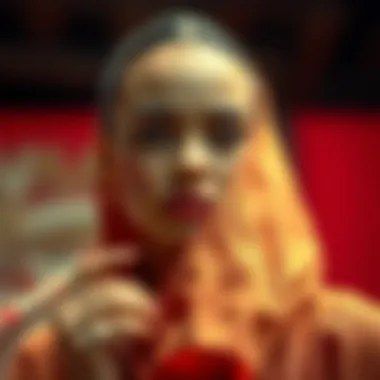

At the heart of every red fabric marker lies a well-crafted blend of inks and dyes. These components are specially formulated to interact with fabric fibers without compromising the fabric's integrity. Dyes, unlike pigments, have a tendency to bond chemically with the fibers, allowing for deeper saturation. This type of interaction encourages vibrant hues and enhances colorfastness.
Fabric markers typically use either water-based or permanent inks. Water-based inks are favored for their ease of use and quick drying properties, but permanent inks can stand the test of time in terms of washability and durability. Essentially, choosing the right ink can mean the difference between a bright, long-lasting design and one that fades after a wash or two.
Safety Considerations
Non-Toxic Formulations
One important aspect of red fabric markers is their non-toxic formulations. As creativity knows no bounds, it's essential to ensure that the materials you use are safe, especially for projects involving children. Non-toxic markers offer peace of mind without sacrificing quality. This characteristic not only fosters a healthier environment but also broadens the scope of situations where these markers are suitable for use.
With numerous brands shifting towards non-toxic options, this choice has grown in popularity. These formulations are often free from harmful solvents or harsh chemicals which can pose health risks. Ultimately, the non-toxic nature of these markers makes them both a responsible choice for artists and a practical one for those working on intricate fabric designs.
"Safety is not just a priority; it is a prerequisite for creativity to flourish."
Environmental Impact
Environmental considerations are increasingly taking center stage in the fabric arts. Using fabric markers with an eye toward their environmental impact is not just a trend; it's a necessity. The market has seen a surge in eco-friendly alternatives that reflect this awareness. Many manufacturers have started to formulate their inks with biodegradable components, significantly mitigating harmful effects on nature.
By choosing markers that prioritize the environment, artists are not only supporting sustainable practices but are also ensuring their work does not contribute to fabric pollution. The unique feature of these eco-friendly formulations is their ability to decompose without leaving behind toxic residues, offering artists a green solution for their creative expressions. However, one must also keep in mind that while some eco-friendly markers may sacrifice certain qualities, such as color vibrancy for environmental benefits, the overall advantage of reducing one's carbon footprint can outweigh these drawbacks.
Choosing the Right Red Fabric Marker
Selecting the appropriate red fabric marker is a critical step that not only influences the quality of your artistic or practical projects but also affects your overall experience. When you're gearing up to customize apparel or embark on an artistic endeavor, the right marker can make all the difference. A well-chosen marker ensures that your work will last, looks vibrant, and meets your specific needs. By understanding key factors related to the selection of red fabric markers, you can elevate your creative processes.
Factors to Consider
Tip Size and Shape
When diving into the realm of red fabric markers, the tip size and shape are paramount. A fine tip allows for detailed work, making it an excellent choice if you're aiming for precision. Think of designing intricate patterns or writing small personal messages; a fine point can deliver that finesse. On the other hand, broader tips can fill in large areas swiftly, ideal for covering surfaces quickly or creating bold statements.
The choice of tip affects how you engage with the fabric.
- Fine tip markers often provide better detail, which is great for stenciling and freehand designs.
- Broad tip markers facilitate quicker filling of large areas, reducing the time spent on mundane applications.
However, another consideration is the actual comfort of using the tip. A rounded tip might be appealing for casual scribbles, but the fine tip is more suited to an artist’s command. Each has its pros and cons depending on the task at hand.
Color Quality and Fastness
Equally essential is the color quality and fastness of the red ink. This characteristic defines how vibrant your colors remain over time and how resistant they are to fading from washing or exposure to sunlight. High-quality ink provides deep, rich hues that stand out on fabric. This means that your artistic creations will maintain their brilliance, no matter how many washes they endure.
A marker with commendable fastness uses pigment-based inks rather than dye-based ones. Pigment inks are less likely to fade, ensuring that t-shirts decorated with your designs remain vivid after wear and tear.
- Vibrancy is key. Rich and striking colors can truly bring your project to life, capturing attention and communicating personality or style.
- Durability matters. Consider how often you'll wash the fabric; markers with excellent color fastness are essential for items like clothing.
Like tip size, the choice of ink can make or break your pieces. Don’t overlook the importance of choosing a red fabric marker that promises saturation and resistance to fading, especially when investing time and effort into your craft.
Brands and Product Recommendations
When it comes to brands, make sure to choose those that are reputed for their quality. A few notable options in the market include:
- Sharpie Fabric Markers: Known for their versatility and wide range of colors including an eye-catching red.
- Tulip Fabric Markers: They offer a variety of tip sizes and great color vibrancy, ideal for various applications.
- Duncan Fabric Markers: These markers are often heralded for their quality and durability, making them a solid choice for artists.
Always look for reviews or demos online before deciding. Popular platforms such as Reddit or dedicated craft forums can offer insightful user experiences that help you steer your decision. By doing your homework, you’ll be equipped to select a red fabric marker that will amplify your creative efforts and yield satisfying results.
Techniques for Effective Use
When diving into the realm of red fabric markers, the techniques for effective use play a crucial role in achieving the desired results. Properly utilizing these markers can elevate artistic expression and enhance the durability of projects. As a bridge between imagination and reality, these techniques are the backbone supporting one's creativity, especially when working with fabric that can often be unpredictable.
Preparation of the Fabric
Before one even thinks about bringing a red fabric marker to life on a surface, preparation of the fabric is essential. Washing the fabric to remove any sizing or oils is a simple yet effective technique that prepares the canvas for better ink adherence. By ensuring that the fabric is clean, not only does it provide a smooth surface for the markers, but it also helps the ink to penetrate deeply, leading to vibrant and long-lasting results.
Additionally, ironing the fabric to smooth out creases can further enhance the experience. Creases can interfere with precise application and lead to uneven results.
In the end, taking these small steps in preparation ensures that the project starts on the right footing, allowing the artist to focus on creativity instead of dealing with unexpected complications later on.
Application Techniques
Applying red fabric markers comes with its distinctive flair, and employing the right application techniques can greatly affect the outcome of the work. Two popular methods in this area include stenciling and freehand, as well as layering and blending, each with unique characteristics that cater to different artistic ambitions.
Stenciling and Freehand
The aspect of stenciling and freehand involves both structure and spontaneity in art. Stenciling offers precision, allowing artists to reproduce exact shapes and designs, which is especially useful for intricate patterns. This technique is popular among those who prefer a defined look. One of the great advantages of stenciling is that it allows for consistency across multiple projects, which is a boon for business or larger art endeavors.
On the other hand, freehand expression lends a more personal touch. The ability to create spontaneous designs reflects an artist's individuality, which resonates with many enthusiasts. Freehand can sometimes seem challenging, especially for those not confident in their skills. However, the freedom it offers can lead to more fulfilling artwork, despite the occasional imperfection.
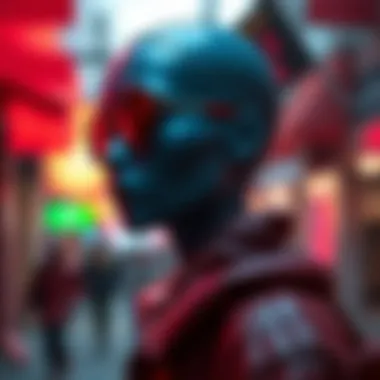

While both methods have their pros and cons, they can also complement each other beautifully, enabling artists to create pieces that are both structured and free-flowing, ultimately shaping the theme and message of the artwork.
Layering and Blending
Layering and blending techniques add depth and dimension, transforming any project into a masterpiece. The concept of layering involves applying multiple coats of color, allowing the artist to achieve different shades. This technique can bring richness to the design, making colors vibrate with life.
Blending, however, is where the magic truly happens. The ability to merge two or more colors can produce stunning effects that make a piece stand out. A notable characteristic of blending is the visual softness it provides, creating gradients that can contour shapes or soften edges.
Despite the beauty of these techniques, they require a steady hand and a bit of patience. Too much layering, for example, might lead to a patchy finish if not done carefully. Yet, when executed correctly, the results are well worth the effort, inspiring a sense of accomplishment that encourages further creative exploration.
Post-Application Care
After the artistic magic has been unleashed, post-application care is vital. Proper care ensures that vibrant red designs remain intact through time and wear. This involves specific washing instructions and the use of fixatives when necessary to lock in colors.
Caring for your fabric after application not only protects the art but also respects the effort put into creating it, be that in customized clothing or intricate textile art.
In summary, refining the techniques for effective use ultimately contributes to an artist's success with red fabric markers, setting the stage for not only enjoyable projects but durable and beautiful creations that can be appreciated for years to come.
Maintaining and Storing Red Fabric Markers
Maintaining and storing red fabric markers properly is vital to ensure their longevity and peak performance. These markers are essential tools for many creative individuals, from fashion enthusiasts to professional artists. Without the right care, however, these tools can become dried out or ineffective, leading to frustration during crucial projects. In this section, we will explore best practices and storage conditions to keep your red fabric markers in prime condition.
Best Practices for Longevity
Regular use is beneficial—frequent application maintains the ink flow, ensuring it doesn't settle or dry out. Here are a few practices to extend the life of your markers:
- Cap them tightly: After each use, be sure to close the cap securely to prevent air exposure, which can lead to drying.
- Clean the tips: If you're switching between colors or notice color build-up, gently wipe the tip with a clean, damp cloth to avoid color muddling.
- Store vertically: Place your markers upright, with the tip facing down. This allows ink to flow towards the tip and keeps the ink well-saturated.
When it comes to ensuring your markers perform every time you reach for them, consistency is key.
Storage Conditions
The environment where red fabric markers are stored can significantly affect their performance. Here are some essential conditions to consider for optimal storage:
- Temperature Control: Avoid exposing markers to extreme temperatures. A cool, dry place is ideal. Humidity can lead to fungal growth in some cases, while high heat can dry out the ink.
- Away from Direct Light: Keeping markers in a drawer or box protects them from UV rays, which can degrade the ink over time.
- Avoid Heavy Objects: Don't stack heavy items on top of your markers, as this can apply pressure that leads to leakage or damage.
Proper maintenance and storage not only preserve your markers but also enhance your creative experience, reducing the hassle of dealing with dry tips or inconsistent ink flow.
By adhering to these methods, you'll ensure that your red fabric markers remain reliable companions in all your creative endeavors. With minimal effort, your markers can stay vibrant for a long stretch, ready to help you bring your artistic visions to life.
Environmental Considerations
As we delve into the world of red fabric markers, it becomes increasingly important to discuss the environmental implications of using such craft supplies. Our choices in the materials we use directly affect the planet, not just in the short term but for generations to come. Understanding environmental considerations helps both individuals and businesses make conscious decisions that align with sustainability goals. In this context, red fabric markers present unique challenges and opportunities worth exploring.
Eco-Friendly Alternatives
In the quest for sustainability, seekers of creative freedom can find plenty of eco-friendly alternatives to traditional red fabric markers. Brands are now prioritizing environmentally friendly formulations. These alternatives often incorporate natural pigments and water-based inks, significantly reducing harmful chemicals in their production. Here are some worth considering:
- Water-Based Inks: These markers use water as a primary solvent, reducing volatile organic compounds (VOCs). This is especially important in closed environments since traditional inks emit harmful fumes.
- Plant-Based Dyes: Natural dyes derived from plants or minerals often produce vibrant colors. While red hues can come from sources like beetroot or madder root, the colors may vary, allowing for unique shades and tones.
- Recyclable Packaging: Some manufacturers are moving to biodegradable or recyclable materials in their packaging. Opting for markers sold in eco-friendly packaging is a step further toward reducing plastic waste.
"Choosing eco-friendly crafting materials not only benefits your artistic endeavors but also fosters a healthier planet."
Sustainable Practices
Adopting sustainable practices while using red fabric markers ensures not just artistry but responsible consumption. Simple adjustments in the way we work with these markers can make a significant difference. Here are a few suggestions:
- Use Sparingly: It's tempting to go all out when creativity strikes, but using only what you need minimizes waste. This includes not overloading the marker when coloring.
- Upcycling Projects: Instead of buying new fabrics, consider revamping old garments or materials. Use red fabric markers to give new life to the items that might otherwise end up in the landfill.
- Dispose Wisely: When markers run dry, recycling them might not be the first thought. However, many areas have special disposal services for hazardous materials. Knowing how to dispose of these markers properly is essential for environmental care.
- Educate Others: Sharing knowledge about sustainable practices with fellow artists can lead to a larger movement. Communities often thrive on shared wisdom, and spreading awareness can inspire change.
By blending creativity with responsibility, artists and consumers alike can truly make a difference in their environmental impact without hindering their expressive journeys.
Future Trends in Fabric Markers
As the world of fabric markers continues to evolve, understanding the future trends in this niche becomes essential for enthusiasts, artists, and retailers alike. The landscape of design and creativity relies heavily on the tools we use, and red fabric markers are no exception. In this section, we will explore key technological advances and market predictions that are shaping the future of fabric markers, particularly how they can support and inspire creative expression in various environments.
Technological Advances
The rise of technology is transforming every industry, and fabric markers are no different. One of the most significant advances is the development of water-based inks that not only offer vibrant colors but also boast improved durability and flexibility. These inks are designed to withstand washing without fading, which is critical for apparel creation and customization. ?
Another trend is the integration of smart technology into the design of fabric markers. Imagine markers that connect to your phone or tablet. These tools could potentially provide users with color matching, design suggestions, or even tutorial videos at the touch of a button. This could bridge the gap between traditional hand-drawn art and digital design, making artistic creation more accessible than ever.
Furthermore, sustainability has become a focal point of innovation. Manufacturers are increasingly focusing on eco-friendly practices, developing markers that are made from recycled materials and employing non-toxic, biodegradable formulations. This shift not only appeals to environmentally conscious consumers but also aligns with the broader trend towards sustainable artistry.
"Our industry needs to adapt to changing consumer values,"* says a representative from one major marker company. *"We see a big push towards sustainable practices, and it's crucial for our markers to reflect that trend."
Market Predictions
As we look ahead, several predictions about the market for fabric markers emerge, especially regarding red markers specifically. Analysts anticipate steady growth driven by increased interest in DIY projects and custom apparel—especially among younger generations. This trend can be attributed to platforms like Instagram and Pinterest that promote sharing personal creativity and uniqueness via social media.
Moreover, the rise in e-commerce has made access to niche craft supplies far easier, further bolstering the market. Online retailers are expanding their offerings, which means that a wider variety of fabric markers will become available to consumers. With this increase in diversity, expect traditional retailers to step up their game to remain competitive, often offering workshops or events to engage local communities.
The demand for instructional content is also likely to climb. Consumers are not just looking to purchase fabric markers; they are hungry for knowledge on how to use them effectively. This could lead to partnerships between brands and content creators, focusing on how-tos and project ideas—not just for red markers, but the entire range of fabric markers available.
In summary, as technological advancements converge with evolving consumer preferences, the future for red fabric markers appears vibrant. From sustainable solutions to smart designs, the landscape promises to be rich with opportunities for innovative applications and unparalleled creativity.


